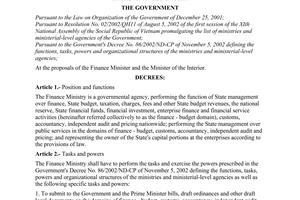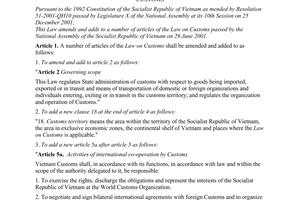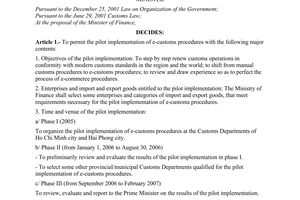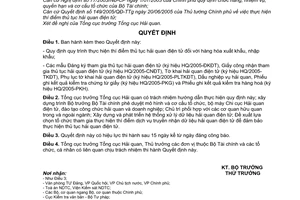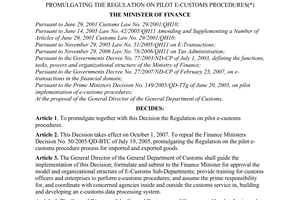Decision No. 50/2005/QD-BTC, promulgated by the Ministry of Finance for the Regulation on the process of experimenting the e-customs procedures for export and import goods. đã được thay thế bởi Decision No. 52/2007/QD-BTC of June 22, 2007, promulgating the regulation on pilot e-customs procedures và được áp dụng kể từ ngày 01/10/2007.
Nội dung toàn văn Decision No. 50/2005/QD-BTC, promulgated by the Ministry of Finance for the Regulation on the process of experimenting the e-customs procedures for export and import goods.
|
THE
MINISTRY OF FINANCE |
SOCIALIST
REPUBLIC OF VIET NAM |
|
No. 50/2005/QD-BTC |
Hanoi, July 19, 2005 |
DECISION
PROMULGATING THE REGULATION ON THE PROCESS OF EXPERIMENTING THE E-CUSTOMS PROCEDURES FOR EXPORT AND IMPORT GOODS
THE MINISTER OF FINANCE
Pursuant to Customs Law No.
29/2001/QH10, which was passed on June 29, 2001, by the Xth National
Assembly of the Socialist Republic of Vietnam at its 9th session;
Pursuant to the Government’s Decree No. 77/2003/ND-CP of July 1, 2003, defining
the functions, tasks, powers and organizational structure of the Ministry of
Finance;
Pursuant to the Prime Minister’s Decision No. 149/2005/QD-TTg of June 20, 2005,
on experimenting the e-customs procedures;
At the proposal of the general director of the General Department of Customs,
DECIDES:
Article 1.- To promulgate together with this Decision:
- The Regulation on the process of experimenting the e-customs procedures for export and import goods;
- Forms of registration for participation in e-customs procedures (code HQ/2005-DKDT), recognition of participation in e-customs procedures (code HQ/2005-CNDT), e-customs declaration (code HQ/2005-TKDT), annex to e-customs declaration (code HQ/2005-PLTKDT), customs operation seal, ticket of paper dossier examination results (code HQ/2005-PKG), and ticket of goods inspection results (code HQ/2005-PKH).
(All these forms are not printed herein).
Article 2.- The general director of the General Department of Customs shall have to guide the implementation of this Regulation; formulate and submit to the Finance Minister for approval models and organizational structures of E-Customs Sub-Departments; provide training to customs officers and enterprises; assume the prime responsibility for, and coordinate with concerned agencies inside and outside the customs service in, building and developing an e-customs data processing system; propose the selection of organizations participating in experimentation of e-customs data transmission services in order to ensure the carrying out of e-customs procedures.
Article 3.- This Decision takes effect 15 days after its publication in “Official Gazette.”
Article 4.- The general director of the General Department of Customs and heads of units under the Finance Ministry, and concerned organizations and individuals shall have to implement this Decision.
|
|
FOR
THE FINANCE MINISTER |
REGULATION
ON THE PROCESS OF EXPERIMENTING THE E-CUSTOMS PROCEDURES
FOR EXPORT AND IMPORT GOODS
(Issued together with the Finance Minister’s Decision No. 50/2005/QD-BTC of
July 19, 2005)
I. GENERAL PROVISIONS
1. Subjects and scope of application
a/ Subjects of application: Enterprises of all economic sectors that voluntarily register the participation in e-customs procedures and their registrations are approved by customs offices.
b/ Scope of application: The e-customs procedures provided for in this Regulation applies to export and import goods under contracts, for which the customs procedures are carried out at the Customs Department of Hai Phong city, the Customs Department of Ho Chi Minh city and Customs Departments of other provinces or cities under the Finance Minister’ decision permitting the experimentation of e-customs procedures.
2. Procedures for registration of participation in the e-customs procedures
a/ Enterprises shall register
the participation in the e-customs procedures (form HQ/2005-DKDT - Appendix 1
to this Decision), and submit the registrations to the E-Customs
Sub-Departments of the localities where they make registration
(This form may be downloaded from
the General Customs Department’s website
http://www.customs.gov.vn);
b/ E-Customs Sub-Departments shall, within 3 working days after receiving the registrations, check the criteria in the enterprises’ registrations and if they are compliant with regulations, submit them to the directors for approval and grant of access accounts and papers of recognition of participation in e-customs procedures (form HQ/2005-CNDT - Appendix 2); if not compliant, they shall notify the refusal, clearly stating the reasons therefor.
II. E-CUSTOMS PROCEDURES
1. E-customs declaration and inspection, receipt and classification of customs dossiers
1.1. E-customs declaration
When making e-customs declaration, enterprises shall perform the following jobs:
a/ To enter e-customs declaration information in computers strictly according to the criteria and standard forms under the guidance of the General Department of Customs and bear responsibility for the accuracy of e-customs declaration information;
b/ To send e-customs declaration information to the E-Customs Sub-Departments of the localities where they make registration;
c/ To receive and perform jobs according to notices guiding the carrying out of e-customs procedures, specifically:
- To amend and/or supplement e-customs declaration information at customs offices’ requests;
- To print declarations (02 copies), based on e-customs declaration information already accepted by customs offices, sign and affix seal on declaration HQ/2005-TKDT (Appendix 3), and annex to declaration HQ/2005-PLTKDT (Appendix 4), if export/import goods contain 4 or more items (hereinafter called printed declarations);
- For goods with e-customs declaration information accepted by the E-Customs Sub-Departments for customs clearance, enterprises shall bring printed declarations to the supervision sections of the Customs Sub-Departments of the border gates where export/import goods arrive (hereinafter called border-gate Customs Sub-Departments for short) for clearance;
- For goods with paper customs dossiers to be produced and submitted before clearance at requests of E-Customs Sub-Departments, enterprises shall submit and produce printed declarations together with paper customs dossiers as requested;
- For goods with paper customs dossiers to be produced and subject to actual inspection at requests of E-Customs Sub-Departments, enterprises shall submit and produce printed declarations together with paper customs dossiers to the E-Customs Sub-Departments and produce goods to border-gate Customs Sub-Departments for inspection as requested;
d/ Particularly for export/import goods on the list of goods banned from export/import or the list of goods subject to conditional export/import, or to assessment, analysis or classification, enterprises shall submit or produce assorted permits, goods quality inspection registrations or inspection-exemption notices, and quarantine registrations, granted by competent state bodies, assessment, analysis and classification results, and/or reconciliation-monitoring tickets (if any) according to regulations (hereinafter referred collectively to as permits).
In order to facilitate the carrying out of e-customs procedures, enterprises are encouraged to submit or produce in advance the above-said permits to E-Customs Sub-Departments.
1.2. Time of inspecting declaration information and time limit for e-customs declaration
a/ Time of inspecting e-customs declaration information
- E-customs declaration information shall be inspected and accepted for registration during the working hours, from 8:00 hrs to 12:00 hrs and from 13:00 hrs to 17:00 hrs (excluding weekends and public holidays).
- Beyond working hours, directors of E-Customs Sub-Departments shall decide to permit the inspection and acceptance of e-customs declaration information at enterprises’ requests.
b/ Time limit for e-declaration
- For import goods, the declaration shall be made before the goods arrive at border gates or within 30 days after the goods arrive at border gates; e-customs declaration information shall be valid for carrying out customs procedures within 15 days after customs offices accept e-customs declaration information.
- For export goods, the declaration shall be made at least 8 hours before transport means exit; e-customs declaration information shall be valid for carrying out customs procedures within 15 days after customs offices accept e-customs declaration information.
1.3. Inspection, registration and classification of e-customs dossiers
a/ When receiving enterprises’ e-customs declaration information, based on the analysis of inspection information and criteria according to regulations, customs offices shall, through the e-customs data processing system, inspect and accept e-customs declaration information or notify enterprises of their refusal to accept, clearly stating the reasons therefor.
b/ If accepting e-declaration information, customs offices shall grant serial numbers of e-customs declarations and make classification in one of the following forms:
- Clearance acceptance on the basis of e-customs declaration information (Green Flow);
- Inspection of paper customs dossiers before clearance (Yellow Flow);
- Inspection of paper customs dossiers and actual inspection of goods before clearance (Red Flow).
c/ To send notices guiding the carrying out of e-customs procedures to enterprises.
1.4. Classification principles
a/ Clearance acceptance on the basis of e-customs declaration information (Green Flow) in the following cases:
a1/ Export goods meet one of the following conditions:
- Export goods (excluding export goods made of imported raw materials);
- Goods subject to conditional export, for which permits have been submitted to customs offices as specified at Point d, Section 1.1 of Part II.
a2/ Import goods of enterprises well observing the customs law, which fully meet the following 2 conditions:
- Goods not on the list specified at Point d, Section 1.1 of Part II; goods on the list specified at Point d, Section 1.1 of Part II for which permits have been submitted or produced to customs offices defined at Point d, Section 1.1 of Part II;
- Goods not subject to immediate tax payment.
a3/ Goods in other special cases to be decided by the Prime Minister;
b/ Inspection of paper customs dossiers before clearance (Yellow Flow) in the following cases:
- Goods on the list specified at Point d, Section 1.1 of Part II, for which permits have not yet been submitted to customs offices;
- Goods subject to immediate tax payment;
- Goods specified at Point a, Section 1.4 of Part II, whose customs dossiers are detected with doubts.
c/ Inspection of paper customs dossiers and actual inspection of goods before clearance (Red Flow) in the following cases:
- Export/import goods of owners that have violated the customs law time and again;
- Goods not specified at Points a and b, Section 1.4 of Part II, based on the results of collection and analysis of risk control information from the database, customs investigation sections, agencies, organizations, individuals and customs offices of different countries, to determine violations of the customs law, which are subject to actual inspection;
d/ For goods specified at Points a and b, Section 1.4 of Part II, which are detected as having signs of violating the customs law, directors of E-Customs Sub-Departments shall decide on appropriate flow changes.
e/ The general director of Customs shall decide on classification criteria in the entire customs service, directors of Customs Departments of the localities where exist E-Customs Sub-Departments shall decide on classification criteria in the localities under their respective management.
1.5. Receipt or supplementation of permits and grant of reconciliation monitoring tickets
a/ Customs officers tasked to receive and supplement permits submitted by enterprises shall perform the following jobs:
- To receive and inspect the validity of permits;
- To enter permits’ contents in the e-customs data processing system;
- To keep permits.
b/ When enterprises file applications for excerpting permits’ contents for carrying out the customs procedures at other Customs Sub-Departments, customs officers shall:
- Cross-check the data on the volumes of actually exported/imported goods with those in the enterprises’ applications. Effect reconciliation and certify the remaining goods volumes in the reconciliation-monitoring tickets for such permits.
- Print, and transfer to heads of customs clearance teams for signature and affixture of operational seal “E-Customs Sub-Departments” (Appendix 5) on, the permit reconciliation-monitoring tickets, and return them to enterprises.
2. Customs clearance for goods
2.1. In case of acceptance of e-customs declaration information and customs clearance (Green Flow)
a/ Enterprises shall bring printed declarations (02 copies) to supervision sections of border-gate Customs Sub-Departments for customs clearance for goods.
b/ The supervision sections of border-gate Customs Sub-Departments shall:
- Receive printed declarations produced by enterprises;
- Inspect criteria of goods already cleared from customs procedures in the e-customs data processing system;
- Compare printed declarations produced by enterprises with e-customs declaration information in the system;
- Certify the e-customs clearance for import goods; or certify e-customs clearance and actual export (for export goods) in printed declarations; sign and affix operational seal “Cleared from e-customs procedures” (according to specimen seal in Appendix 5) on box 32 of printed declarations, hand 01 copy to the customs declarer, 01 to the E-Customs Sub-Department for archival); printed declarations already signed and affixed by customs offices with operational seal “Cleared from e-customs procedures” shall have equal validity as ordinary declarations;
- Update certification results in the e-customs data processing system;
- Cancel certification of actual export in the e-customs data processing system, for goods already certified as actually exported but not exported.
2.2. In case of inspection of paper customs dossiers (Yellow Flow)
a/ Enterprises shall submit and produce printed declarations (02 copies) together with paper customs dossiers to E-Customs Sub-Departments as requested.
b/ Customs officers shall inspect on a case-by-case basis paper customs dossiers submitted and produced by enterprises regarding commodity line policies, tax policies, customs value, goods codes and origins; if taxes must be re-calculated after dossier inspection, payable tax amounts shall be determined, based on current law provisions; enter inspection results in the system; print tickets of paper dossier inspection results (02 copies) HQ/2005-PKG (Appendix 6), together with enterprises’ representatives, sign thereon for certification and return 01 copy to enterprises and keep 01 copy together with the paper dossiers already inspected at E-Customs Sub-Departments:
- Certify the customs clearance in the system if the submitted and produced documents are valid and compatible with e-customs declaration information;
- Request actual inspection of goods before clearance in case of doubts;
- If detecting violations of the customs law, handle them according to current regulations;
c/ If goods are cleared from customs procedures immediately, heads of customs clearance teams of E-Customs Sub-Departments shall approve the inspection results and decide on clearance in the system. The customs clearance for goods shall comply with the provisions of Section 2.1 of Part II.
d/ If goods are subject to actual inspection, directors of E-Customs Sub-Departments shall decide on actual inspection of goods before clearance. The actual inspection shall comply with the provisions of Points c, d, e, f, g and h, Section 2.3 of Part II.
e/ If goods are subject to analysis, classification or expertise assessment, border-gate Customs Sub-Departments shall be requested to take samples for assessment. The taking and keeping of assessed samples shall comply with current regulations. Right after the assessment, analysis or classification results are available, border-gate Customs Sub-Departments shall send them to E-Customs Sub-Departments for completion of procedures. Customs clearance for goods in these cases is effected as follows:
- If goods are subject to analysis, classification or assessment for determination of whether they are eligible for export/import, after samples are taken according to regulations, directors of border-gate Customs Sub-Departments shall decide to allow goods owners to bring back their goods for preservation, if such goods meet the customs supervision requirements. Goods shall be cleared from customs procedures only after the analysis, classification or assessment results are available.
- If goods are subject to analysis, classification or assessment for determination of payable tax amounts after samples are taken according to regulations, directors of E-Customs Sub-Departments shall decide on customs clearance without having to wait for assessment results.
f/ If goods are subject to customs value determination, directors of E-Customs Sub-Departments shall decide on customs clearance for goods, and at the same time, transfer paper customs dossiers to post-clearance inspection sections under E-Customs Sub-Departments.
g/ For goods subject to inspection of paper customs dossiers before clearance, and several documents are unavailable (commercial invoices, detailed lists of goods, certificates of origin of goods), but E-Customs Sub-Departments approve the definite delayed submission thereof, such goods shall be accepted for clearance.
h/ For goods for which payable tax amounts have not yet been paid or fully paid within set time limit, but the payable tax amounts are guaranteed by credit institutions or other organizations licensed to conduct several banking operations, such goods shall be accepted for clearance.
2.3. In case of inspection of paper customs dossiers and actual inspection of goods (Red Flow)
a/ Enterprises shall submit and produce printed declarations (02 copies) together with paper customs dossiers to E-Customs Sub-Departments as requested.
b/ Customs officers at E-Customs Sub-Departments shall inspect documents produced by enterprises as requested regarding commodity line policies, tax policies, customs value, goods codes and origins; enter inspection results in the system; print tickets of paper dossier inspection results (02 copies) and, together with enterprises’ representatives, sign thereon for certification; hand over printed declarations together with paper customs dossiers to enterprises for the latter to bring them to border-gate Customs Sub-Departments for actual inspection of goods.
c/ Enterprises shall produce goods to border-gate Customs Sub-Departments for actual inspection.
d/ Customs officers at border-gate Customs Sub-Departments shall conduct actual inspection of goods as requested regarding forms and extents of actual inspection in the system, which are decided by heads of E-Customs Sub-Departments; the actual inspection may be conducted with the use of machinery, technical equipment or other operational measures; enter inspection results in the system; print tickets of goods inspection results (02 copies) HQ/2005-PKH (Appendix 7) and, together with enterprises’ representatives, sign thereon for certification.
e/ The E-Customs Sub-Departments shall inspect the calculation of taxes on taxable export/import goods, which are subject to tax re-calculation after actual inspection. Taxes shall be calculated in the system, based on current law provisions.
f/ Heads of customs clearance teams of E-Customs Sub-Departments shall approve inspection results and decide on customs clearance in the system.
g/ Border-gate Customs Sub-Departments shall keep paper customs dossiers and transfer them to E-Customs Sub-Departments, hand over printed declarations (02 copies) to enterprises.
h/ In cases where goods are eligible for customs clearance, subsequent jobs specified in Section 2.1 of Part II shall be performed. If violations of customs law are detected, they shall be handled according to current regulations.
2.4. Tax and customs fee collection and remittance
a/ Enterprises must fulfill tax and customs fee obligations under notices of E-Customs Sub-Departments through the e-customs data processing system, specifically:
- For goods subject to immediate tax payment, after customs offices accept e-customs declaration information and grant serial numbers of e-customs declarations, enterprises shall pay taxes according to notices guiding the carrying out of e-customs procedures and produce tax payment documents or documents of credit institutions or other organizations licensed for several banking operations, guaranteeing payable tax amounts, to E-Customs Sub-Departments before clearance;
- For goods eligible for tax grace, enterprises must pay taxes according to notices guiding the carrying out of e-customs procedures in the grace period according to the provisions of law;
- Customs fees for goods lots already cleared from customs procedures in a month shall be paid between the 1st and 10th day of the following month at E-Customs Sub-Departments.
b/ Customs officers of E-Customs Sub-Departments shall:
- Collect taxes and monitor tax payment, tax arrears and tax accounting according to regulations;
- Calculate and collect monthly customs fees according to regulations.
2.5. Supporting enterprises and settlement of complaints
a/ Enterprises participating in e-customs procedures shall be trained in, and provided with documents on, e-customs procedures; and they may request customs offices to settle problems arising in the course of carrying out e-customs procedures.
b/ E-Customs Sub-Departments shall have to guide, provide documents to, and settle problems of, enterprises, which are related to e-customs procedures. If such problems fall beyond their competence, they must promptly report and propose them to superior customs offices.
c/ All questions, complaints or disputes shall be settled on the basis of e-customs declaration information kept in the e-customs data processing system.
2.6. Handling of violations
a/ Directors of E-Customs Sub-Departments shall handle violations according to their competence provided for by law, and enter handling results in the system.
b/ For goods subject to actual inspection, border-gate Customs Sub-Departments conducting actual inspection of goods shall handle violations if detecting them, and enter handling results in the system.
3. Post-clearance inspection
3.1. Principles
a/ Post-clearance inspection constitutes a stage in the customs operation process, aiming to evaluate the observance of customs law by customs declarers.
b/ All information in e-customs declarations, printed declarations, customs dossiers, accounting books and vouchers, and other documents related to export/import goods already cleared from e-customs procedures, are subject to post-clearance inspection, including goods, in case of necessity and if conditions permit.
c/ E-Customs Sub-Departments shall conduct post-clearance inspection of export/import goods cleared from customs procedures thereat on the basis of analyzing and processing information from the database, paper customs dossiers and information from other professional sections, agencies, organizations, individuals and customs offices of different countries.
d/ Enterprises shall have to submit and produce customs dossiers, accounting books and vouchers, and other documents related to export/import goods with e-customs procedures already cleared from e-customs procedures, including goods, in case of necessity and if conditions permit, to E-Customs Sub-Departments, when so requested.
3.2. Post-clearance inspection jobs by E-Customs Sub-Departments
a/ To receive and keep printed declarations and paper customs dossiers (for goods subject to actual inspection) already cleared from e-customs procedures, sent monthly by border-gate Customs Sub-Departments.
b/ To collect information on the basis of:
- Inspection of e-customs declaration information for goods eligible for clearance;
- Inspection of paper customs dossiers already received and kept;
- Customs database;
- Information from other professional sections;
- Information from agencies, organizations, individuals and customs of different countries.
c/ On the basis of inspection results, if detecting signs of violating commodity policies, tax policies, customs value, or goods codes or origins, to request enterprises to bring paper customs dossiers and other documents related to goods for inspection according to regulations; enter inspection results in the e-customs data processing system. Within the time limit set in the amended and supplemented Export Tax and Import Tax Law, if enterprises can redress by themselves errors and mistakes in e-customs declaration and tax calculation and payment, customs offices shall not issue decisions on post-clearance inspection.
d/ To classify, analyze and assess information in order to determine objects and extents of post-clearance inspection; draw up plans on post-clearance inspection; report thereon to directors of provincial/municipal Customs Departments for approval and decision on post-clearance inspection.
e/ To take post-clearance inspection steps at enterprises according to the provisions of law and enter post-clearance inspection results in the system.
4. Risk control
The risk control sections of E-Customs Sub-Departments shall perform the following tasks:
a/ To collect information and data from the database, paper customs dossiers, from customs clearance, post-clearance inspection and customs investigation sections, and information from agencies, organizations, individuals and customs offices of different countries.
b/ To classify, analyze, assess and process in time information for risk determination in service of customs clearance for goods, post-clearance inspection and smuggling combat in their respective localities.
c/ To compile dossiers on enterprise management according to the extents of enterprises’ observance of the customs law;
d/ To enter the results in the system in service of customs operations.
e/ To propose classification and post-clearance inspection criteria and submit them to leaders of E-Customs Sub-Departments.

